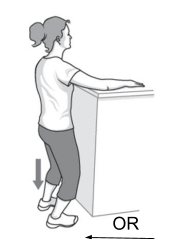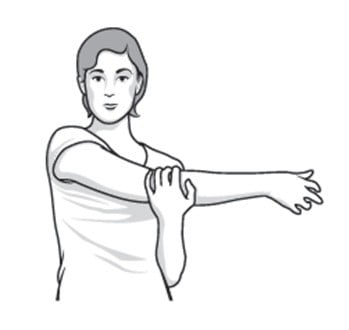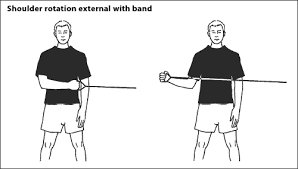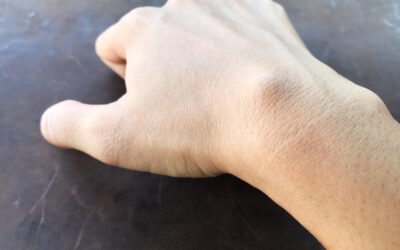Frozen shoulder basically block mobility in the shoulder joints, which causes severe pain in the shoulders. However, this problem is often seen in women other than men. It interferes the daily activity of the victim and can be very painful. Through this article, we will tell you what is frozen shoulder, symptoms and causes and how to cure frozen shoulder quickly.
It can take a severe look over time and completely block shoulder activity if not treated. Range-of-motion exercise is considered effective in the treatment of shoulder stiffness or frozen shoulder. In some cases arthroscopic surgery may be recommended to treat shoulder capsules.
What Is Frozen Shoulder?
Frozen Shoulder is also known as Adhesive Capsulitis. This is a condition that affects the shoulder joints of the victim. The condition of the frozen shoulder usually involves swelling, stiffness and pain in the shoulder joints. It develops gradually and becomes more serious over time. It may take one year to three year to treat.
The human shoulders are composed of three bones, which form the Ball and Socket Joint. These three bones are the upper arm (Humerus), solder bladder (scapula) and the collarbone (clavicle). There are some tissues around the shoulder joint called shoulder capsules.
In case of shoulder stiffness, tissues in shoulder joint or shoulder capsules become thicker and tighter and scar tissue develops after some time and synovial fluid decreases. As a result, it decreases shoulder speed, and you may face symptoms like swelling, pain and stiffness etc. The problem of shoulder stiffness or frozen shoulder usually develops more between the ages in 40 and 60 years.
Frozen Shoulder ICD 10.
Frozen shoulder ICD10 is also know as adhesive capsulitis shoulder, thereby code for frozen shoulder ICD10 is M75.00. Left frozen shoulder ICD10 is M75.02 and right frozen shoulder ICD10 is M75.01.
Symptoms.
The main symptoms associated with the frozen shoulder includes pain and stiffness. These symptoms make shoulder activity difficult or impossible. The symptoms of frozen shoulder develop slowly and cause disruption in daily work over time. Pain in case of shoulder stiffness can cause more discomfort at night and disturb your sleep. In addition, shoulder inflammation can also occur. In fact, the symptoms of the shoulder stiffness (frozen shoulder) depend on its stage, and the symptoms also change along with the stage.
Stages of Frozen Shoulder.
The problem of frozen shoulder usually develops slowly in three stages. Each stage can last for several months.
Freezing Stage.
This stage hurts shoulder activity and gradually begins to be limited. The method of this stage varies from 6 to 9 months.
Frozen Stage.
Pain may decrease during this stage. But in this situation the shoulder stiffness increases over the side, and it becomes more difficult to use in daily activity. This stage can last from 4 to 12 months.
Thawing Stage.
This stage improves shoulder activity. It may take from 6 months to 2 years. But you may feel pain at night, which can also prevent your sleep.
Signs That Frozen Shoulder Is Starting To Thaw.
The signs are:
- Motions of shoulder starts to improve.
- Pain stays in same place more than 2 day.
Causes.
This problem arises when the shoulder capsules or joint tissues become stiff, thick and hardly stick around the shoulder joint, i.e., the formation of scar tissue. In this situation, shoulder activity begins to be blocked. But it is not clear why the problem of frozen shoulder develops in some individuals. But many risk factors may be responsible for this problem. Persons aged 40 years and above, especially women are more prone than men. Additionally, other risk factors of frozen shoulder are the following, such as;
- Hormonal imbalance.
- Diabetes.
- Hyperactive thyroid (Hyperthyroidism) or Underactive Thyroid (Hypothyroidism).
- Weak immune system.
- Lack of mobility in shoulder activity due to injury or illness.
- Surgery.
- Due to heart disease, thyroid or Parkinson’s Disease etc.
Diagnosis.
If a person feels frozen shoulder and pain, he or she should consult a doctor. The doctor may try to diagnose the symptoms with the help of physical examination during physical testing. Attempts are made to check the pain and evaluate the extent of activity. With the help of physical examination the doctor can determine the present condition of muscle activity. In some cases, the doctor may use an anesthetic in the clinical process.
A physical test may usually be enough to diagnose shoulder stiffness or frozen shoulder, but the doctor may also take the help of imaging tests such as X-rays, ultrasound or MRI to diagnose other problems like Anesthetic or Torn Rotator Cuff.
How To Cure Frozen Shoulder Quickly?
Usually the following processes can be used to treat to cure shoulder stiffness or frozen shoulder quickly, such as;
- Physical Therapy.
- Medication.
- Surgery.
- Home Care etc.
Physical Therapy.
Physical therapy is the most common treatment for frozen shoulder. During this process, the doctor try to increase shoulder activity and reduce pain. It may take from a few weeks to 9 months to achieve effective results. Range-of-Motion Exercises is important under physiotherapy.
Medication.
The doctor may recommend over-the-counter nonsteroidal anti-inflammatory drugs such as Aspirin, Ibuprofen or Naproxen Sodium to treat symptoms such as pain and joint inflammation. A steroid injection can also help to reduce shoulder stiffness or frozen shoulder. In order to reduce pain and improve shoulder speed, the doctor may recommend applying corticosteroid injection to the shoulder joint.
Surgery.
Surgery is quite rare for the treatment of frozen shoulder. But if any treatment process does not help in treating shoulder stiffness or frozen shoulder, the doctor may recommend surgery to remove damaged cells and stiffness from inside the shoulder joint.
Doctor usually uses the Arthroscopic procedure for surgery. In this process light tubular devices are inserted through small cuts in the shoulder to remove scar or damaged tissues by surgery using arthroscopy. Usually after this procedure, the patient can do all kinds of activities within three months.
Additionally, the doctor may inject sterile water into the patient’s shoulder capsule, which can help to move the shoulder easily.
Prevention.
There is no proper way to prevent shoulder stiffness or frozen shoulder. But starting physical therapy immediately after a shoulder injury can help to reduce the risk of shoulder stiffness (frozen shoulder). Doing proper exercise regularly can improve shoulder activity and applying ice packs on the shoulder for 15 minutes 2 to 3 times a day can reduce pain and also help to reduce the symptoms of frozen shoulder. The problem of frozen shoulder caused by surgery or injury can be prevented with the help of range-of-motion exercise and stretching. But it is not possible to protect some case of frozen shoulder.
Intake of vitamin D and friendly bacteria rich diet intake can help to strengthen the immune system and help to reduce the risk of frozen shoulder.
Frozen Shoulder Massage.
The ‘soft tissue release’ a kind of massage done by physiotherapist helps to relieve frozen shoulder by improving blood circulation and breaking scar tissue. This scar tissue often develops when the shoulder and its surrounding structure stiff.
Frozen Shoulder Triggering Point.
The myofascial trigger points in muscles of the shoulder and its surrounding area causes frozen shoulder. The triggering points are lumps, muscle knots or sensitive area.
Frozen Shoulder Massage Techniques.
A massage therapist is professionally trained to apply specific massage methods to relieve pain, stress and manage certain conditions such as frozen shoulder.
In addition, the physical therapist is trained to manipulate the ligaments and administer sports massage and physiotherapy treatments to repair soft tissues.
Trigger Point Therapy.
Trigger point therapy focuses on muscle lumps or tight muscle areas in your shoulders and neck. These trigger points not only cause pain in their exact location but can also cause pain in other areas of the body. Frozen shoulder massage that uses trigger point therapy uses pressure and release method to work on those tight areas. The affected shoulder should experience some pain relief and improve mobility.
Deep Tissue Massage.
A deep tissue massage, sometimes called myofacial massage, uses slow, firm pressure to relieve stress. Your massage doctor will press deeply into your soft tissue to reach the deepest areas of muscles, mantles, ligaments and tendons. The mantle is a protective layer on the muscles, joints and bones. Releasing this specific tissue can reduce stiffness and improve speed limits. Applying deep tissue massage to people with frozen shoulder can help massage therapists help victims gain mobility and reduce pain.
Heat Therapy.
Heat is used in many ways to reduce stress and pain. Warmth increases blood circulation and relaxes the muscles. Your massage doctor will be able to work deeply in the affected hand while combining a professional massage with heat which will release adhesion and stiffness.
Swedish Messages.
A Swedish massage uses long strokes to relieve stress from muscles. This technique is probably the most popular massage treatment. This option is beneficial for people who cannot handle the pressure of deep tissue or trigger point massage therapy. Swedish massage will not release trigger points but can improve overall muscle stress and promote relaxation.
Frozen Shoulder Diet.
Diet for frozen shoulder, it is important to reduce the amount of inflammation, so your diet should focus on including foods that have anti-inflammatory properties. Here are some effective foods which can cure frozen shoulder quickly:
- Oily fish (which contains omega 3 fatty acids).
- Fruits with anti-inflammatory properties (pineapple, berries, red grapes).
- Vegetables containing antioxidants, which eradicate harmful compounds from the body (such as broccoli, cauliflower, cabbage, sweet potato, etc.).
- Nuts, seeds, avocados, olive oil.
- Spices like turmeric and ginger.
- Probiotic-rich foods (yogurt, kombucha, etc.).
Diabetic Frozen Shoulder.
People with diabetes are at an increased risk of developing frozen shoulder as unmanaged blood sugar levels can affect collagen, a major protein that makes up your connective tissue.
Cortisone Shot for Frozen Shoulder.
Cortisone injections are given directly into or near the shoulder joint. It reduces inflammation within the frozen shoulder joint.
Frozen Shoulder Exercises Video.
Here is the video for frozen shoulder exercises.
How to Sleep with Frozen Shoulder?
Sleeping with frozen shoulder is usually difficult. To help you stay comfortable while sleeping, you can place a pillow under your affected hand, place your hand on your stomach. If you sleep with a saw, make sure you don’t sleep on the affected shoulder. Similarly, place your affected hand on the pillow across your chest as if hugging it. It is one of the effective way for frozen shoulder pain relief at night.
Frozen Shoulder Menopause.
Experts have mentioned a connection between menopause and frozen shoulder as many women who have received frozen shoulder were undergoing menopause at the same time. Thus, the level of hormones that fluctuate during menopause can be responsible for frozen shoulders in menopausal women.
Frozen Shoulder vs Rotator Cuff.
With the injury of the rotator cuff, the speed limit of your hand may be limited, but you can lift it manually. On the contrary, a frozen shoulder is characterized by a dull or painful pain and a limited range of motion makes it difficult to lift the hand above a certain point.
Frozen Shoulder After Rotator Cuff Surgery.
Shoulder surgery for conditions such as rotator cuff tier, proximal humers fracture, shoulder instability and arthritis can result in stiffness due to aggressive scars forming during the treatment process. Prolonged stabilization can lead to rigidity to protect surgical repairs.
Frozen Shoulder Cures in 1 Minute.
- Getting the movement back – exercise when shoulder exercises are less painful.
- Pain Relief – Avoid activities that hurt you. Just gently move your shoulder.
- Relief from strong pain and swelling – prescribed painkillers. Steroids may be injected into your shoulder to reduce inflammation.
Hydrodilation for Frozen Shoulder.
Hydrodilation is a process where a needle is placed in the shoulder joint using ultrasound or X-ray to guide the location, and injecting corticosteroids, local anesthetics and sometimes sterile water to spread the combined capsule.
Exercise for Frozen Shoulder.
Here are some exercises to cure frozen shoulder quickly. Physiotherapy Exercise for Frozen Shoulder are;
Pendulum Exercise.

This exercise uses a technique in which the humerus is removed from the glenoid fossa using gravitational power. In this way, it is tried to relieve pain through light trembling and vibration. Keep your shoulders in a relaxed position for the practice of this exercise. Stand upright and bend, so that the affected arm is pointed downwards. Now, gently rotate the arm. Rotate 10 times with 10 sets in clockwise and anti-clockwise direction.
Towels Help In Increasing Stretch.

Shoulder Internal Rotation with Towel
Take a long towel, hold it with one hand and tie it on the shoulders and back. Take the other hand to the back and hold the towels. Slowly move the towels up and down, so that your hand can move all over the back. You can also feel light stretch in your shoulders and back. Repeat it 10 times with 5 sets.
Armpit Stretch.

Top 5 Frozen Shoulder Exercise
Lift the arm (other than effected arm) to the front of the chest. Gently bend your knees and let the armpits open. Bend the knees a little more and let the arms open further. Keep a little more stretch every time the knee bends, but don’t force. Repeat for 10-15 times with 3 sets.
Cross-Body Reach.

Lift the bruising arm from your second arm to the elbow and bring it to your body level, stretch slightly to stretch the shoulders. Stay in the same state for 30 seconds. Repeat 5 to 10 times with 3 times.
Outward And Inward Rotation.

An attempt is made to rotate your wrist with the help of the band or stretch band. Tie the band with your leg or a door latch. Place your elbows near your body and at 90-degree. Rotate 10 times on the outside and 10 times inward and repeat this exercise 10 times.
Physiotherapists can sometimes take the help of heat, even before the exercise. It will enhance joint activities and also provide better stretching. Ice packs can be used to reduce the discomfort after the exercise.
*Note: There are many exercises that can be used to relieve the frozen shoulder. Similar exercises are joint mobilization techniques and special stretching exercises. Patients advised to prefer a detail check up by a qualified physiotherapist and try to get a rest from the pain by building a special program for themselves.
Frequently Asked Questions (How To Cure Frozen Shoulder Quickly).
1. Can I lift weights at the gym after treating my frozen shoulder with physiotherapy?
No, you should avoid to life heavy weights in the gym or in your daily activities as it may increase the pain in your affected areas. You should practice stretching exercise and also massage the affected area with lukewarm water twice daily.
2. Can frozen shoulder pain lead to heel pain?
No, in frozen shoulder it affected shoulder muscles consists rotator cuff muscle i.e., the supraspinatus, the subscapularis the infraspinatus and the teres minor muscles. These holds the ball of the humerus to the glenoid socket. However, according to the doctors and victims it do not cause heel pain.
3. Can I go for a walk with frozen shoulder?
No, walking with the frozen shoulder can worse your condition as shoulder movements can increase the pain. Tendons in your arm will have to work harder which can result in tendonitis. You can practice some above mentioned stretching exercise.
Bottom Line.
Due to stressful lifestyle many people are at risk of having frozen shoulder. Therefore, it is necessary to look after your health by avoiding stress along with healthy diet and also include regular exercises in your daily lifestyle. With the help of these easy exercises you can easily cure frozen shoulder quickly.
+4 Sources
-
Freaktofit has strict sourcing guidelines and relies on peer-reviewed studies, educational research institutes, and medical organizations. We avoid using tertiary references. You can learn more about how we ensure our content is accurate and up-to-date by reading our editorial policy.
- Frozen Shoulder; https://my.clevelandclinic.org/health/diseases/15359-frozen-shoulder
- The Humerus; https://teachmeanatomy.info/upper-limb/bones/humerus/
- Scapula; https://www.britannica.com/science/scapula
- The Clavicle; https://teachmeanatomy.info/upper-limb/bones/clavicle/

 Workout
Workout
 Meditation
Meditation


 Stories
Stories


 Podcast
Podcast E-book
E-book











